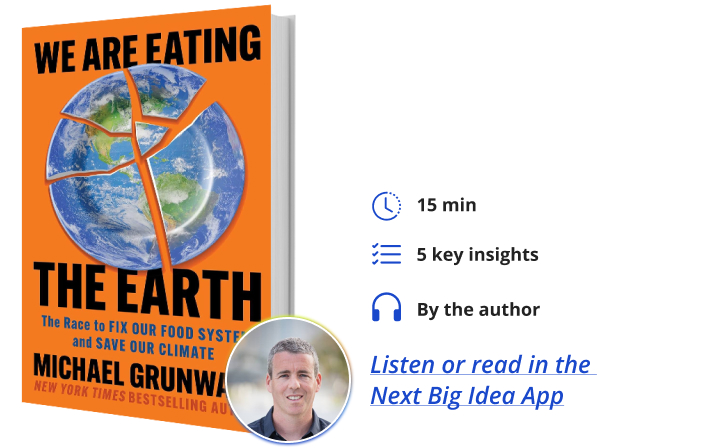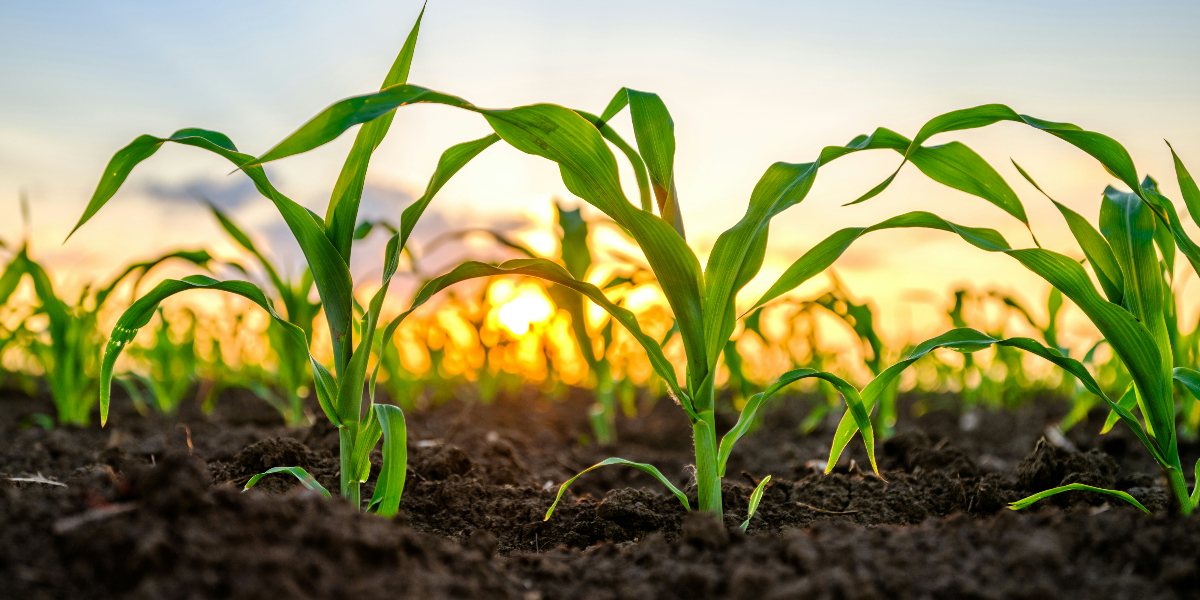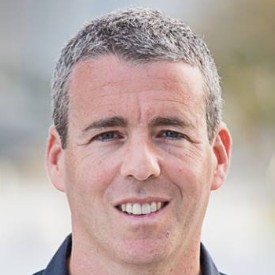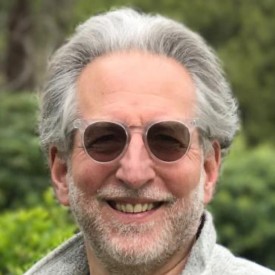Michael Grunwald is the bestselling author of two widely acclaimed books, The Swamp and The New New Deal. He is a former staff writer for The Washington Post, Time, and POLITICO, and winner of the George Polk Award for national reporting, the Worth Bingham Award for investigative reporting, and many other journalism prizes.
What’s the big idea?
We need to figure out how to produce food in a way that won’t destroy the planet. Even if we all stopped using fossil fuels tomorrow, the Earth would still broil if we didn’t fix food and farms. The carbohydrate problem is a lot tougher to solve than our hydrocarbon problem—we basically know what must happen if we want sustainable energy. But food’s role in the climate problem is getting worse, and we don’t know how to solve it. Raising awareness about the fight to feed the world without frying the Earth is a critical step to coming up with and getting behind solutions.
Below, Michael shares five key insights from his new book, We Are Eating the Earth: The Race to Fix Our Food System and Save Our Climate. Listen to the audio version—read by Michael himself—below, or in the Next Big Idea App.

1. We are eating the Earth.
Two out of every five acres of land are farms or pastures. By contrast, only one in every 100 acres is cities or suburbs. Our natural planet is becoming an agricultural planet. We lose a soccer field’s worth of forest every six seconds. That’s a disaster for frogs and monkeys and other forest critters, but it’s also a disaster for us because it releases the carbon from forests into the atmosphere and prevents them from sucking carbon out of the atmosphere in the future. Forests soak up a quarter of our emissions, so trying to decarbonize the planet while vaporizing trees is like trying to clean your house while smashing the vacuum to bits in the living room: you make a mess and cripple your ability to clean up the mess.
Agriculture makes a lot of messes. It slurps up 70 percent of all fresh water, so it’s parching rivers, like the Colorado, and aquifers, like the one that provides California’s groundwater. It’s the leading driver of water pollution, creating the algal blooms choking the Great Lakes and a giant dead zone in the Gulf of Mexico. Its diesel tractors emit carbon dioxide; its fertilizers and manure emit nitrous oxide; its cow burps and farts emit methane, which is a real problem even if it sounds goofy.
But its biggest threat to the planet and climate is its relentless march into carbon-rich wilderness. We’ll need to produce about 50 percent more calories to feed the world by 2050, and we’re currently on track to deforest another dozen Californias worth of land to do it. We don’t have another dozen Californias of forest to spare.
2. Meat is a problem, and beef is a disaster.
We use a land mass larger than Europe and Asia combined for agriculture. Three of every four of those acres grow grass or crops for animals to eat before we eat them. In general, eating plants is way more efficient than eating the animals that eat plants. We must feed eight calories of feed to a chicken to generate one calorie of meat. That feed supports feathers and beaks and clucking and pooping and all kinds of stuff that doesn’t produce meat. And beef is 10 times worse for the climate and planet than chicken or pork. That’s partly because of the methane burps, but it’s mostly because cattle and other ruminants use so much land. They’re extraordinarily inefficient converters of their food into our food. Even dairy is worse than chicken or pork, but cows can produce milk several times a day, and they only produce beef once.
“The average American eats the equivalent of three burgers a week, and cutting that to two would save a land mass the size of Massachusetts every year.”
I cut out beef and lamb when I started working on We Are Eating the Earth, because I wanted to eat less of the Earth. Vegan diets are the best way to do that, but I’m too weak to go vegan, and my diet is about as eco-friendly as going vegetarian, because most vegetarians load up on dairy. In the United States, we get 3 percent of our calories from beef, and we use 50 percent of our agricultural land to produce beef. The good news is that we’ve reduced our per capita beef consumption by a third over the last half century—we’re not eating less meat, just switching to chicken, but that shift inadvertently did more to cut emissions than any shift before the rise of solar. And we still eat four times as much beef as the global average, so there’s plenty more room for improvement. The average American eats the equivalent of three burgers a week, and cutting that to two would save a land mass the size of Massachusetts every year.
The world is on track to eat 70 percent more ruminant meat by 2050. Beef is delicious; for many Americans it is still (as the slogan says) what’s for dinner. Fake meat could fix a lot of these problems, but it’s not yet as tasty and cheap as animal meat, so consumers haven’t embraced it. And while the government could try to discourage beef consumption, one pollster told me that taxes and other restrictions on meat were the least popular policies he’s ever polled, “up there with veterans’ benefits for ISIS.”
Still, just as Willie Sutton robbed banks because that’s where the money was, emissions hawks need to focus on beef because that’s where the emissions are. That means trying to eat less beef and figuring out ways to make better beef. That’s not organic grass-fed beef; cattle that spend their entire lives in pastures are worse for the climate than feedlot-finished beef, partly because they take longer to reach slaughter weight, so they burp more methane, but mostly because they use even more land. Better beef really means more efficient beef; in Brazil, I saw ranches that used to support one cow every five acres improved to support one cow every acre, so they used one-fifth as much of the Amazon to produce the same amount of beef. If beef were only two times as bad as chicken rather than 10 times, we’d eat way less of the Earth.
3. We need a greener Green Revolution.
The Green Revolution is shorthand for the technological transformation of agriculture since the 1960s, characterized by high-yield seeds, fertilizers derived from fossil fuels, chemical pesticides, large-scale irrigation, and automated factory farms that utilize optimized breeding and feeding to process billions of animals into food. People are angry about the way modern industrial agriculture treats animals and workers, the way it lobbies against environmental regulation, and makes too much of a mess. I get it. But another thing the Green Revolution did was triple crop and livestock yields. That means we’re making three times as much food per acre; otherwise, we’d need three times as many acres to make food. Factories excel at manufacturing massive amounts of cheap commodities, and factory farms excel at manufacturing food.
“Organic yields are typically 20 to 40 percent lower than those of conventional yields.”
Over the next 25 years, we need to manufacture even more food than we’ve grown over the last 12,000 years without using more land. That math sucks. Yields will have to increase even faster than they’ve increased since the Green Revolution—and as the Earth warms, more droughts and floods and heat waves will make that harder. Rolling back the Green Revolution could make that impossible. Sri Lanka’s government attempted to ban agrochemicals and shift to organic farming; yields plummeted, food prices skyrocketed, and the government fell. Organic yields are typically 20 to 40 percent lower than those of conventional yields.
Partly because, Michael Pollan writes, there’s a broad perception that the small rustic red-barn farms of yesteryear, where soil was nurtured with love and animals had names instead of numbers, were natural and benign, and their conversion into huge industrial farms that erode the soil and drench monoculture crops in chemicals was an environmental disaster. It’s true that there’s often an environmental cost to intensification, but the real environmental disaster was the transformation of prairies and forests into those rustic Michael Pollan farms. The conversion of nature into agriculture stripped away most of the carbon and biodiversity. And again, kinder and gentler low-yield agriculture that produces less food per acre requires more land to grow the same amount of food, leading to more wild land being converted into farmland.
Nevertheless, a coalition of major philanthropies is trying to drag farming back to the old ways, calling for a $4 trillion global transition to regenerative agro-ecology. They have support from UN agencies, green groups, the global Save the Soil movement, and even major agribusinesses and Big Food conglomerates like Archer Daniels Midland and General Mills. This is where most of the energy and money in the food and climate space is flowing: toward a faith-based reinvention of food production.
If you’ve seen documentaries like Carbon Cowboys, Kiss the Ground, or Common Ground, you know this movement also claims regenerative practices can reverse global warming by transferring gigantic amounts of carbon we’ve pumped into the sky back into the soil. The idea is that “carbon farming” can transform agriculture from a climate problem to a climate solution, and corporate polluters are trying to offset their emissions by paying farmers millions of dollars through private carbon markets to sequester carbon in agricultural soils.
4. Carbon farming is mostly bogus.
Planting trees and shrubs in fields and pastures is a perfectly valid way to store carbon above ground on agricultural lands. But it’s hard to measure carbon in soil, hard to make sure it stays underground, and almost impossible to make more of it without applying more nitrogen, which has its own climate problems. There’s a ton of magical thinking around this stuff.
“It’s hard to measure carbon in soil, hard to make sure it stays underground, and almost impossible to make more of it without applying more nitrogen, which has its own climate problems.”
You’ll hear regenerative brands selling carbon-neutral beef and carbon-negative milk, but those aren’t real. General Mills financed a climate analysis that claimed a regenerative ranch in Georgia was carbon-neutral, but when you look at the fine print, it uses more than twice as much land per pound of beef as a conventional ranch, and the study doesn’t assign that any climate cost. In other words, it treats land as if it were free—just like those original studies of biofuels that Tim Searchinger debunked in Science.
5. Fixing all these messes will be hard.
The Kiss the Ground fantasy where all that bad carbon trapping heat in the sky becomes good carbon helping crops grow in our soils is one of those magic bullet solutions that sound awesome in theory. I hear all the time: We don’t need to grow more food, we just need to go vegan. Or, we need to stop wasting the food we already make. Yes, we would eat much less of the Earth if we stopped eating meat, but we ate more than 350 million tons last year, we’ll eat more this year, and nobody has a plan to get to zero. Yes, it’s dumb that we waste a quarter of our food, which wastes a quarter of the farmland and fertilizer and water we use to grow our food, but if it were easy to stop wasting food, then the average American family wouldn’t waste $1,500 a year doing it. Even if rich countries cut meat consumption in half, all countries cut food waste in half, and we stopped using farms to grow fuel, then we’d still need to make more food with less land. The math is that ugly.
I try not to be a Debbie Downer, and there are dozens of promising solutions: Meat and dairy substitutes made from plants or fungi or animal cells; Invisible biotech coatings that help prevent food from spoiling; Chemical and natural feed additives that help cattle burp less methane; Bio-pesticides that use the mRNA technology to constipate potato beetles to death; Bio-fertilizers that use gene-edited microbes to fetch nitrogen from the air and feed it to crops. At the University of Illinois, scientists are literally reinventing photosynthesis, which has done a pretty good job sustaining life on Earth for a few billion years, but turns out to have some real inefficiencies. They’re using artificial intelligence, gene editing, and Big Data to engineer those inefficiencies away to ratchet up crop yields.
None of these solutions has much traction yet, but that doesn’t mean we’re doomed. Two decades ago, there were no energy solutions with any traction. We need to hurry up and conduct more research into what works, and then we need to deploy the stuff that works. We need better policies that create better incentives, and we need better accounting that recognizes the value of land. What we ultimately need is a better land ethic that treasures every acre as a potential source of nutrition to help feed us or carbon storage to help save us, and tries to help every acre live up to its potential.
Enjoy our full library of Book Bites—read by the authors!—in the Next Big Idea App:
































